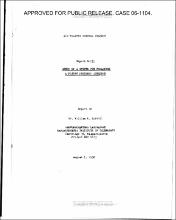| dc.contributor.author | Linvill, William K. | en_US |
| dc.date.accessioned | 2009-06-03T17:36:39Z | |
| dc.date.available | 2009-06-03T17:36:39Z | |
| dc.date.issued | 1950-08-01 | en_US |
| dc.identifier | MC665_r11_R-191.pdf | en_US |
| dc.identifier.uri | http://hdl.handle.net/1721.3/39820 | |
| dc.description.abstract | A schedule-following system for an airplane is a servomechanism. By use of conventional design techniques the system can be made to operate successfully up to the limits of the fixed part of the system, which is the airplane itself and the navigation system. For a Lockheed Constellation and an accurate (± 250 feet) navigation system, the speed control can have a bandwidth of about 0.4 cycle per minute and a speed range of about ± 15 percent of cruising speed, and the position can be controlled to within about ± 500 feet. Winds and navigation noise are the main corrupting disturbances on the system. By proper design of the control system, the effect of winds on ground speed can be diminished almost to extinction as long as the required air speed is within the range of the airplane engine. Navigation-system errors cannot be overcome by compensation.
During initial approach, use of airbrakes to provide negative thrust and use of gravity to provide additional positive thrust can increase the incremental thrust range by a factor of four for a descent of 1 foot in 10. | en_US |
| dc.language.iso | en | en_US |
| dc.publisher | MIT Servomechanisms Laboratory | en_US |
| dc.relation.ispartofseries | MIT DIC 6673 | en_US |
| dc.relation.ispartofseries | Project Whirlwind Report R-191 | en_US |
| dc.relation.ispartofseries | Project Whirlwind Collection, MC665 | en_US |
| dc.title | Study of a System for Following a Flight Progress Schedule | en_US |
| dc.type | Technical Report | en_US |
